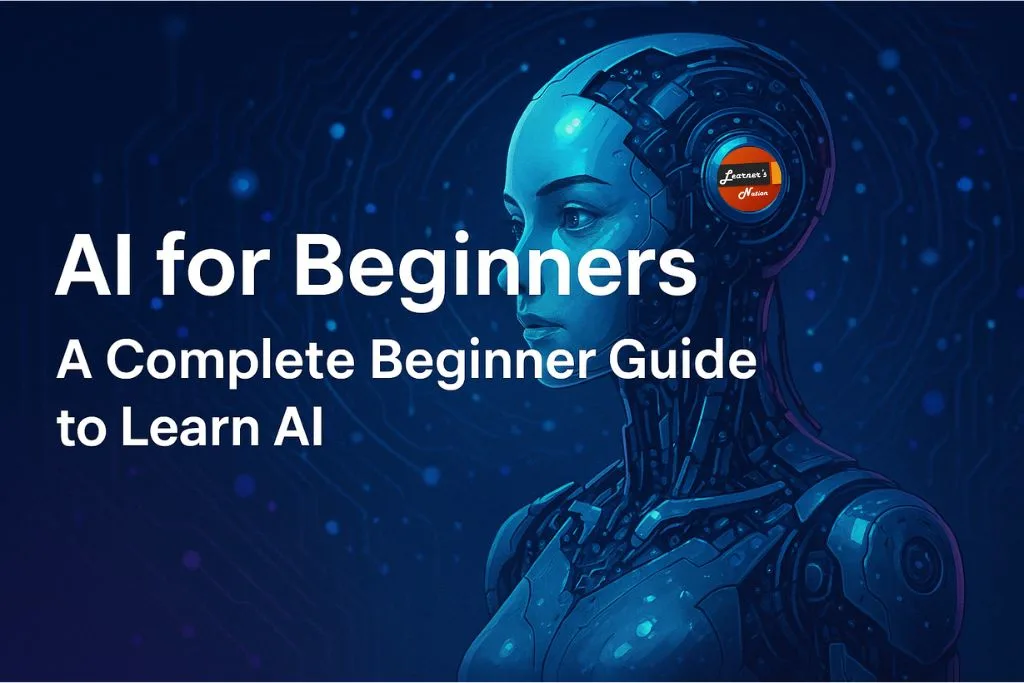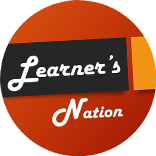AI for Beginners: How Students Can Start Learning Artificial Intelligence Today
Why AI Matters for Everyone Today
Artificial Intelligence (AI) is no longer a distant or complicated technology limited to tech giants or PhDs in computer science. Today, it is woven into the very fabric of our daily lives—often without us even realizing it. From unlocking your phone using face recognition to receiving personalized recommendations on YouTube, Spotify, or Netflix, AI is silently working behind the scenes to make our experiences smoother, smarter, and faster.
If you’re curious about how this powerful technology works and want to get started, check out our complete beginner guide to learn AI in 2025—a step-by-step path designed to help anyone, regardless of background, understand and master the fundamentals of artificial intelligence.
Everyday Examples of AI in Our Lives
Think about your typical day. You might ask Google Assistant or Siri about the weather, get navigation help from Google Maps, or chat with a customer support bot on a shopping website. These are all powered by different types of artificial intelligence:
- Voice Assistants (Alexa, Siri, Google Assistant) use natural language processing (NLP) to understand and respond to your questions.
- Recommendation Engines on YouTube, Amazon, and Netflix use AI algorithms to suggest content or products tailored to your preferences.
- Social Media Feeds on platforms like Instagram and Facebook are organized by AI to show you posts you’re most likely to engage with.
- Spam Filters in Gmail or auto-correct features in smartphones are also examples of machine learning in action.
These experiences may feel simple on the surface, but they are all possible because of complex AI models working in the background.

How AI Is Transforming the Future of Work and Learning
AI is not just changing how we consume content—it’s redefining entire industries and careers. In fields like healthcare, AI helps doctors detect diseases earlier using imaging and predictive models. In education, AI is being used to create personalized learning paths for students. In business, it helps automate repetitive tasks, optimize supply chains, and enhance decision-making.
For students, this transformation means two things:
- AI is becoming a necessary skill.
Whether you want to be a doctor, teacher, entrepreneur, or artist, knowing how AI works—or at least understanding its basics—can give you an edge in your career. Many future jobs will either directly involve AI or require collaboration with AI tools. - AI is reshaping how we learn.
Students can now use AI-powered platforms like ChatGPT to solve doubts instantly, get personalized study recommendations, and even write or debug code with guidance. AI helps create a more flexible, supportive, and interactive learning environment.
Why Students Should Learn Artificial Intelligence Early
Artificial Intelligence is quickly becoming one of the most important skills of the 21st century. For students, getting a head start in AI is not just an academic advantage—it’s an investment in a future full of opportunity, innovation, and personal growth. Learning AI early helps build a strong foundation in technology while nurturing skills that are essential in nearly every career path.
Career Advantages and Future-Proofing Skills
AI is not just limited to tech companies anymore. It is revolutionizing industries like healthcare, finance, education, agriculture, logistics, and even entertainment. By learning AI early, students can unlock doors to some of the most in-demand and high-paying careers of the future:
- AI/ML Engineers, Data Scientists, Automation Specialists, and AI Product Designers are already in high demand.
- According to several job market studies, roles that involve AI are growing 70% faster than other tech jobs.
- Even non-technical careers—from journalism to marketing—are being reshaped by AI tools. Understanding AI makes you more adaptable and competitive in any field.
Starting young gives students a long runway to experiment, fail, learn, and improve, which puts them ahead of others by the time they enter college or the workforce.
Moreover, as automation and AI begin replacing repetitive jobs, people with AI literacy will be the ones creating and managing these intelligent systems—not just competing with them.
Enhancing Creativity, Problem-Solving, and Tech Literacy
Learning AI isn’t just about math, code, or robots. It also teaches creative thinking and real-world problem-solving. Whether it’s designing a smart game, building a chatbot, or creating an app that recognizes emotions through facial expressions—students get to turn ideas into working solutions.
Here’s how AI learning enhances key skills:
- Creativity: Tools like Teachable Machine and Scratch with ML extensions let students experiment visually and creatively without writing complex code.
- Logical Thinking & Problem Solving: Understanding how an AI model learns or how to train it with data builds analytical and structured thinking skills.
- Digital & Tech Literacy: Learning Python, data handling, and basic machine learning helps students become confident users and creators in a digital world.
No Coding? No Problem: Beginner-Friendly AI Tools
One of the biggest myths about learning AI is that you need to be a coding expert or a computer science student. The truth is, many AI tools are now designed for absolute beginners—even those with zero programming experience. These tools help students grasp complex AI concepts in a fun, visual, and interactive way.
1. ChatGPT: Your AI Tutor for Q&A, Explanations, and Code Generation
ChatGPT, developed by OpenAI, is like having a 24/7 AI mentor. It can help students understand difficult topics, generate ideas, write code, and even debug errors. With natural language processing, it interacts just like a human, so you don’t need to learn any technical commands.
Use ChatGPT to:
- Ask questions like “What is machine learning?” or “Explain neural networks in simple words.”
- Generate sample Python code for small AI projects.
- Summarize long texts, research papers, or lectures.
- Brainstorm project ideas or get help with assignments.
2. Google’s Teachable Machine: Train Your Own AI—No Code Needed
Teachable Machine by Google is one of the best no-code AI tools for beginners. It allows students to train simple machine learning models using images, sounds, or poses. The best part? No programming required at all.
What you can do with Teachable Machine:
- Train a model to recognize your hand gestures or facial expressions.
- Create an image classifier that identifies objects around you.
- Test how AI learns from examples using your webcam or microphone.
3. Scratch + AI Extensions: Visual Learning for Younger Students
For school-age students or absolute beginners, Scratch (developed by MIT) is a drag-and-drop programming platform that now supports AI through extensions like the Machine Learning for Kids plugin.
Why Scratch + AI is great:
- It introduces core AI ideas like training and predictions in a game-like environment.
- Students can create games, quizzes, or animations that respond to voice, images, or custom data.
- No typing or code syntax—just visual blocks to move and connect.
Tools like ChatGPT, Teachable Machine, and Scratch make it possible for anyone—even those with no coding background—to experiment, create, and understand how artificial intelligence works. These tools lower the barrier to entry and make AI learning fun, accessible, and hands-on.
Top Free Courses to Start Learning AI
If you’re a student wondering “Where should I start learning AI?”, the good news is that you don’t need to spend any money or have a technical degree to begin. There are high-quality, free courses created by some of the top minds and companies in the AI world—specially designed for beginners.
Here are three of the best beginner-friendly courses to kick-start your AI learning journey:
1. AI for Everyone by Andrew Ng (Coursera)
Best for: Absolute beginners with no coding background
Created by Dr. Andrew Ng—one of the most respected figures in AI—this course is a gentle, non-technical introduction to the world of artificial intelligence. It explains what AI is, how it’s being used in industries, and how it might impact jobs and society.
Link: AI For Everyone – Coursera
2. Intro to Machine Learning by Kaggle
Best for: Beginners ready to try coding
Kaggle, a platform by Google for data science competitions and learning, offers this free course that teaches the basics of machine learning using simple Python code. Don’t worry—it walks you through each step with interactive lessons and real datasets.
Link: Intro to Machine Learning – Kaggle Learn
3. Google’s Machine Learning Crash Course
Best for: Students who enjoy hands-on, interactive learning
Offered by Google AI, this course combines video lectures, real-world case studies, and interactive coding exercises using TensorFlow (a popular AI framework). It’s slightly more advanced than the previous two but still beginner-friendly.
Link: Machine Learning Crash Course – Google
These courses are 100% free, trusted by professionals, and great stepping stones for deeper AI learning later.
Fun AI Project Ideas for Students
Learning AI becomes much more exciting when you apply your knowledge to build something real. Even as a beginner, you can create simple yet impressive AI projects that teach you core concepts through hands-on experience. These projects don’t require expensive hardware or expert-level coding—just curiosity, free tools, and a little creativity!
Here are three fun and beginner-friendly AI projects you can try as a student:
1. Build a Chatbot Using ChatGPT or Python
Creating your own chatbot is a great way to understand how natural language processing (NLP) works. You can start by using ChatGPT itself as an API or build a basic chatbot in Python using simple rules or pre-trained models.
Use tools :
- ChatGPT API (OpenAI) – Use it to create a conversational assistant or homework helper.
- Python + NLTK / ChatterBot – Great for a simple chatbot that answers FAQs.
2. Create an Image Recognition Model with Teachable Machine
Want to teach a computer to recognize hand signs, facial expressions, or classroom objects? You can do that easily with Google’s Teachable Machine, which lets you build image classification models with zero coding.
Tools to use:
- Teachable Machine (Images option)
- Webcam or camera for capturing training data
3. Develop a Simple Recommendation System
Have you ever wondered how Netflix or YouTube suggests videos? That’s a recommendation system at work. You can build a mini version that recommends books, songs, or movies based on user preferences.
Tools to use:
- Python + Pandas + Scikit-learn
- Sample user data in CSV format (can be created manually)
Why These Projects Matter
These projects will teach you concepts of Reinforce core AI, Builds problem-solving and critical thinking skills.
Best YouTube Channels for AI Beginners
1. Simplilearn
Great for professional-style tutorials with beginner-friendly AI concepts and industry use cases.
Watch: “What is AI?”, “AI vs ML vs DL”
Link : Simplilearn YouTube
2. freeCodeCamp
Offers full-length, hands-on AI and machine learning courses with real coding.
Watch: “Machine Learning for Beginners – Full Course”
Link : freeCodeCamp YouTube
3. Codebasics
Explains AI and ML in simple language (English + Hindi), great for Indian students.
Watch: “Build Your Own Recommendation System”
Link : Codebasics YouTube
4. Tech With Tim
Perfect for coding real AI projects using Python, games, and neural networks.
Watch: “Build AI for Snake Game”
Link : Tech With Tim YouTube
AI Learning Path for Students: Step-by-Step Roadmap to Master Artificial Intelligence
Artificial Intelligence (AI) is no longer just a buzzword—it’s shaping our future. From chatbots to self-driving cars, AI is transforming every industry. If you’re a student or beginner and wondering how to start learning AI, this guide is your clear, no-nonsense roadmap.
Step 1: Understand AI Concepts (No Coding Needed)
Before jumping into code or tools, take time to understand what AI really is.
Focus On:
– What is Artificial Intelligence, Machine Learning, and Deep Learning?
– How machines learn using data (supervised, unsupervised, reinforcement learning)
– Real-life AI applications: voice assistants, facial recognition, self-driving cars
Step 2: Try AI Without Coding
You don’t need to be a programmer to start using AI. There are no-code and low-code tools that let you create fun projects while learning.
Beginner Tools to Explore:
- Teachable Machine by Google – Train models using images or sounds
- Scratch + ML Extensions – Great for visual learners
- ChatGPT – Ask questions, explore how AI generates text
- Lobe.ai – A free tool for training image classification models
Step 3: Learn Python – The Language of AI
If you’re serious about AI, it’s time to learn Python. It’s beginner-friendly, and the #1 language used by AI professionals.
Step 4: Build Real AI Projects
Build real projects that combine your learning.
Project Ideas:
- Chatbot with ChatterBot or OpenAI API
- Image classifier using Teachable Machine or TensorFlow
- Movie or book recommendation system using basic data
- Spam detection using text classification
Start with public datasets (Kaggle, UCI Machine Learning Repository), or use your own data for more personalized projects.
Step 5: Join AI Learning Communities
Don’t go it alone. Join a community to learn faster, ask questions, and stay updated.
Use platform :
- Reddit: r/LearnMachineLearning, r/Artificial
- Discord: AI learner servers and tech community hubs
- Kaggle: Compete, learn from notebooks, ask questions
- LinkedIn/GitHub: Showcase your projects and network
Learning AI as a student might seem hard—but it’s totally doable when you follow a structured path:
Understand → Explore tools → Learn Python → Build → Connect
The secret? Start small and stay consistent. Whether you’re in school, college, or learning from home, this AI roadmap will guide you from confusion to creation.
Start Your AI Journey Today
There’s never been a better time to begin learning AI—tools are more accessible, resources are free, and even students with no coding or tech background can start right away. Whether you’re curious about how AI works or dreaming of building your own smart apps, taking the first step today can open up exciting career paths and future-ready skills. Start small, stay consistent, and let your curiosity lead the way!
FAQs: Common Questions Students Have About Learning AI
Q1. Do I need to know math to learn AI?
Not at the beginning. You can start with beginner-friendly tools and concepts without much math. However, as you dive deeper—especially into machine learning—you’ll benefit from understanding basic algebra, probability, and linear algebra.
Q2. How long does it take to learn AI?
It depends on your goals. With 1–2 hours a day, you can grasp basic AI concepts and tools in 1–2 months. To become skilled in building your own AI models, it might take 6–12 months of consistent practice.
Q3. What devices or software do I need?
You just need a laptop or desktop with internet access. Most beginner tools (like Teachable Machine, ChatGPT, or Google Colab) run on the cloud—no high-end computer needed. Python and beginner libraries are free and easy to install too.
Resources and Further Reading
Official AI Tools & Platforms
- OpenAI – Use ChatGPT, explore APIs, and access documentation
- Google Teachable Machine – No-code AI model training
- TensorFlow – Open-source machine learning framework by Google
- Hugging Face – Pretrained models and datasets for NLP and more
Beginner Guides & Documentation
- Google AI Learning – Courses and resources by Google
- Kaggle Learn – Hands-on coding tutorials
- Scikit-learn Documentation – Easy ML library with examples
- Coursera – AI for Everyone by Andrew Ng
Books for AI Learners
- AI for Kids by Dale Lane – Visual and practical intro for students
- Artificial Intelligence: A Guide for Thinking Humans by Melanie Mitchell – Easy-to-understand concepts
- Python Machine Learning by Sebastian Raschka – Great once you’re comfortable with Python
- Hands-On Machine Learning with Scikit-Learn, Keras, and TensorFlow by Aurélien Géron – Project-based advanced book



